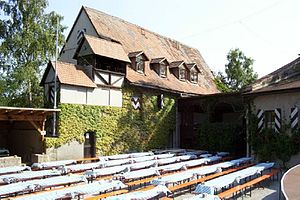Brattenstein Castle
| Brattenstein Castle | ||
|---|---|---|
|
Inner courtyard of the castle |
||
| Creation time : | First mentioned in 1230 | |
| Castle type : | Location | |
| Conservation status: | Received or received substantial parts | |
| Place: | Röttingen | |
| Geographical location | 49 ° 30 '30.4 " N , 9 ° 57' 55.8" E | |
|
|
||
The Brattenstein Castle is a late medieval castle on the north east corner of the city wall in Röttingen in the district of Würzburg in the Tauber Valley .
history
Probably in the 12th – 13th The castle, built in the 16th century, was first mentioned in a document in 1230. Between 1230 and 1345 the castle was owned by the Lords of Hohenlohe , who sold it to the Würzburg monastery in 1345 . In 1438 the castle was conquered and the existing wall belt expanded. In 1440 the castle complex outside the village was included in the city fortifications . Around 1500 a tithe barn was built in the south corner of the castle complex. From 1520 the castle was the seat of a prince-bishop's bailiff, who was regarded as the extended arm of the Würzburg prince-bishop. Extensions and renovations took place in the early 17th century.
In 1803 the prince-bishop's office in Röttingen was abolished and the castle became the seat of the Bavarian Rent Office until the First World War . During this time, the keep on the northeast corner of the castle was demolished. During the Second World War (1939–1945) the castle was used by the Reich Labor Service . After 1945 the castle served as a refugee camp and later housed an Aschaffenburg clothing factory.
On November 5, 1971, the east wing of the castle collapsed. The collapse occurred while the rubble-filled dog kennel on the castle wall was being dismantled and the outer wall lost its last statically effective support. Inside, renovations to expand the premises had previously been carried out. Four employees of the textile company lost their lives in the collapse. The destroyed wing was rebuilt and restored in the following years.
In 1952 Kurt Freudinger , who had been displaced from his home country, wrote a game in three acts out of gratitude ( Peasants' War 1525, Swedish War 1626 and Pest) and dedicated it to the city of Röttingen and "its able citizens". The premiere with Röttinger amateur actors took place in 1954 in the courtyard of the castle against the backdrop of the tithe barn . The original manuscript is kept in Röttingen.
The Röttinger Festival, which is now called the Franconian Festival, has been taking place in the castle courtyard since 1984.
The newly built east wing was inaugurated in June 2018.
literature
- Hermann Ackermann: Thoughts on the collapse of Brattenstein Castle in Röttingen . Deutsche Burgenvereinigung (Ed.), In: Journal "Burgen und Schlösser" 1973/1, p. 50ff. Braubach / Rhine 1973
- Anton Rahrbach, Jörg Schöffl, Oto Schramm: Palaces and castles in Lower Franconia . Nuremberg 2002
- Kurt Freudinger: From the past of the city of Röttingen an der Tauber - using the local chronicle by Michael Wieland 1904 / Ochsenfurt-Weltz, 1954
- Kurt Freudinger: Heimatspiel - dedicated to the town of Röttingen and its able citizens , 3 scenes from the local history of the beneficiate Wieland, based on historical sources, premiered in Brattenstein Castle in 1954
Web links
- Official website of the Röttingen Franconian Festival at Brattenstein Castle
- Entry on Brattenstein Castle in the private database "Alle Burgen".
- Brattenstein Castle at burgenwelt.de
- / Writings of Kurt Freudinger about the Ochsenfurt Gau


